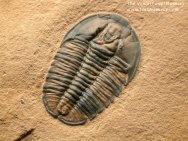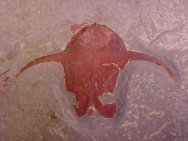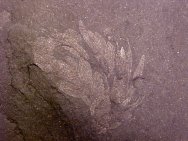Fossils from the House Range in Utah
 Arguably,
Utah is America’s most fossiliferous state. In fact,
a Utah geological map is a mosaic of colors, with formations
spanning
geological time from the Cambrian.
The Cambrian period is especially well represented in Utah’s
fossil record and its House Range is one of the most famous
Cambrian fossil localities in the world. The House Range (see
accompanying images) includes the Wheeler Shale
and the overlying Marjum Formation, which
are exposed throughout the House Range and nearby mountain
ranges
west of the town of Delta, Utah. The Wheeler Shale is named
for a great bowl-shaped feature in the House Range known as
the Wheeler Amphitheater,
while the Marjum Formation is named for its outcrops at Marjum
Pass, also in the House Range. While much of the
Arguably,
Utah is America’s most fossiliferous state. In fact,
a Utah geological map is a mosaic of colors, with formations
spanning
geological time from the Cambrian.
The Cambrian period is especially well represented in Utah’s
fossil record and its House Range is one of the most famous
Cambrian fossil localities in the world. The House Range (see
accompanying images) includes the Wheeler Shale
and the overlying Marjum Formation, which
are exposed throughout the House Range and nearby mountain
ranges
west of the town of Delta, Utah. The Wheeler Shale is named
for a great bowl-shaped feature in the House Range known as
the Wheeler Amphitheater,
while the Marjum Formation is named for its outcrops at Marjum
Pass, also in the House Range. While much of the  Wheeler
Shale lacks fossils, certain layers contain abundant trilobites
and other shelly fossils. The Wheeler Shale
and Marjum Formation also contain a diverse
biota of soft-bodied
fossils, including many of the same taxa found in the
more famous Burgess Shale,
which qualifies the House Range as a Lagerstätte containing
the evolutionary outcome of the Cambrian
Explosion. The soft-body preservation found in the House
Range fossils supports the inference that anoxic
conditions sometimes existed. The central portion of the House
Range also contains the Weeks Formation,
a
limestone that
overlies the Marjum Formation and also contains well preserved
trilobites and a broad diversity of soft-bodied Cambrian Explosion
fauna. Certain horizons of these formations qualify them as
Konservat-Lagerstätten (conservation Lagerstätten)
in which deposits are known for the extraordinary preservation
of diverse fossilized life forms, especially where the soft
parts are preserved.
Wheeler
Shale lacks fossils, certain layers contain abundant trilobites
and other shelly fossils. The Wheeler Shale
and Marjum Formation also contain a diverse
biota of soft-bodied
fossils, including many of the same taxa found in the
more famous Burgess Shale,
which qualifies the House Range as a Lagerstätte containing
the evolutionary outcome of the Cambrian
Explosion. The soft-body preservation found in the House
Range fossils supports the inference that anoxic
conditions sometimes existed. The central portion of the House
Range also contains the Weeks Formation,
a
limestone that
overlies the Marjum Formation and also contains well preserved
trilobites and a broad diversity of soft-bodied Cambrian Explosion
fauna. Certain horizons of these formations qualify them as
Konservat-Lagerstätten (conservation Lagerstätten)
in which deposits are known for the extraordinary preservation
of diverse fossilized life forms, especially where the soft
parts are preserved.
 During
the Lower Cambrian (570 to 540 mya), western Utah was covered
by a shallow sea. Sediments arrived from rivers flowing across
the sandy lowlands of eastern Utah. Sand that was deposited
near the shoreline eventually metamorphosed into quartzite,
while finer sediments and silts that were deposited farther
to sea eventually underwent lithification
to become siltstone, sandstone,
and shale.
During the Middle to Late Cambrian (540 to 500 mya) the inland
sea’s shoreline migrated east; this subsidence
resulted in a relatively complete sequence in western Utah spanning
the Cambrian. Utah was located near the equator during the Cambrian,
so the water temperature was warm. The combination of warm,
shallow water and nutrient-rich silt enabled a highly diverse
fauna. The trilobites were particularly abundant and diverse
due to the multiple environmental niches that they could occupy.
During
the Lower Cambrian (570 to 540 mya), western Utah was covered
by a shallow sea. Sediments arrived from rivers flowing across
the sandy lowlands of eastern Utah. Sand that was deposited
near the shoreline eventually metamorphosed into quartzite,
while finer sediments and silts that were deposited farther
to sea eventually underwent lithification
to become siltstone, sandstone,
and shale.
During the Middle to Late Cambrian (540 to 500 mya) the inland
sea’s shoreline migrated east; this subsidence
resulted in a relatively complete sequence in western Utah spanning
the Cambrian. Utah was located near the equator during the Cambrian,
so the water temperature was warm. The combination of warm,
shallow water and nutrient-rich silt enabled a highly diverse
fauna. The trilobites were particularly abundant and diverse
due to the multiple environmental niches that they could occupy.
 The
House Range is most famous for its trilobites (Many House
Range trilobites are here), with specimens residing in museums
throughout the world. More than 500 species are described. The
most famous trilobite found prodigiously throughout the House
Range is Elrathia kingi. Trilobites of Order
Agnostida are also diverse. Other invertebrates are also
abundant, including sponges such as Diagonella
and Choia,
and Chancelloria,
brachiopods, and echinoderms. Gogia,
an early echinoderm
of class Eocrinoidea (also called eocrinoid for “dawn
crinoid”), are abundant. More than twenty species of non-mineralized
arthropods have been described from the Wheeler Shale, as well
as annelids,
priapulids,
and other worms, and the predator Anomalocaris,
terror of the Cambrian. Brachiocaris
and Pseudoarctolepis,
enigmatic Phyllocarids, are probable crustacean
arthropods. Emeraldella,
which may be a basal Chelicerate,
has similarities to
The
House Range is most famous for its trilobites (Many House
Range trilobites are here), with specimens residing in museums
throughout the world. More than 500 species are described. The
most famous trilobite found prodigiously throughout the House
Range is Elrathia kingi. Trilobites of Order
Agnostida are also diverse. Other invertebrates are also
abundant, including sponges such as Diagonella
and Choia,
and Chancelloria,
brachiopods, and echinoderms. Gogia,
an early echinoderm
of class Eocrinoidea (also called eocrinoid for “dawn
crinoid”), are abundant. More than twenty species of non-mineralized
arthropods have been described from the Wheeler Shale, as well
as annelids,
priapulids,
and other worms, and the predator Anomalocaris,
terror of the Cambrian. Brachiocaris
and Pseudoarctolepis,
enigmatic Phyllocarids, are probable crustacean
arthropods. Emeraldella,
which may be a basal Chelicerate,
has similarities to  Parapaleomerus
sinensis from the Chengjiang Biota
of China. Naraoia,
soft-bodied trilobitomopha, often called soft-bodied trilobites,
are found. Wiwaxia,
a putative, primitive annelid first described from the Burgess
Shale also occurs in the House Range.
Parapaleomerus
sinensis from the Chengjiang Biota
of China. Naraoia,
soft-bodied trilobitomopha, often called soft-bodied trilobites,
are found. Wiwaxia,
a putative, primitive annelid first described from the Burgess
Shale also occurs in the House Range.
 Examination
of Utah stratigraphy reveals fossiliferous rocks of every period
from the Precambrian Proterozoic onward. Millard County alone
has fossils from almost every period except, maybe the Jurassic
and Cretaceous (though some old-timers claim the Cretaceous
is represented). There are 10 distinct known Cambrian and Ordovician
formations in the House Range; these include the lower Cambrian
Prospect Mountain Quartzite, lower to middle Cambrian Pioche
Formation, middle Cambrian Howell Limestone, Chisholm Formation,
DomeLimestone, Whirlwind Formation, Swasey Limestone and then
the well-known Wheeler Shale, Marjum Formations and Weeks Limestone.
The Ordovician is represented by the Orr Formation, Notch Peak
Formation, and the Pogonip Group, which comprises the House
Limestone and the Fillmore Formation (Reference, personal communication
with Delta, Utah resident, Robert Drachuk). The chart at the
right shows Hintze’s and Robison’s 1975 representation
of the Cambrian
stratigraphy in the House Range.
Examination
of Utah stratigraphy reveals fossiliferous rocks of every period
from the Precambrian Proterozoic onward. Millard County alone
has fossils from almost every period except, maybe the Jurassic
and Cretaceous (though some old-timers claim the Cretaceous
is represented). There are 10 distinct known Cambrian and Ordovician
formations in the House Range; these include the lower Cambrian
Prospect Mountain Quartzite, lower to middle Cambrian Pioche
Formation, middle Cambrian Howell Limestone, Chisholm Formation,
DomeLimestone, Whirlwind Formation, Swasey Limestone and then
the well-known Wheeler Shale, Marjum Formations and Weeks Limestone.
The Ordovician is represented by the Orr Formation, Notch Peak
Formation, and the Pogonip Group, which comprises the House
Limestone and the Fillmore Formation (Reference, personal communication
with Delta, Utah resident, Robert Drachuk). The chart at the
right shows Hintze’s and Robison’s 1975 representation
of the Cambrian
stratigraphy in the House Range.
Gaines,
et. al. has recently studied the taphonomy of the Wheeler
Shale
delineating how some layers preserve soft-bodied organisms,
normally with an absence of trilobites, while others preserve
trilobites, normally without other creatures with soft parts
preserved. In particular, Elrathia trilobite laden biofacies
and those with soft part preservation are mutually exclusive.
The authors hypothesize the cause was differing degrees
of bioturbation.
When bioturbation was low, irrigation by seawater of impermeable
clay-rich sediment was reduced allowing organic decay to
proceed
by means of sulfate reduction in anoxic sediments. The chemical
process increased alkalinity and precipitated carbonate
within
pore spaces which further restricted bacterial activity; horizontal
pyritized burrows are described that are typical of sediments
formed under oxygen-depleted bottom waters. The Elrathia biofacies,
in contrast, exhibit dolomite precipitated in trilobite
carapaces,
forming trilobite "nodules." The Elrathia biofacies,
in contrast, probably represent deposition under dysaerobic
consitions where bioturbation was greater, increasing bottom
water oxygen content that, in turn, mediated more rapid decomposition
of soft tissues and colonization by a benthic fauna.
References:
Briggs,
D.E., Lieberman, B., Hendricks, JR., Halgedahl, SL., & Jarrard,
RD. 2008. Middle Cambrian arthropods from Utah. Journal
of Paleontology, 82(2): 238-254.






